ThE forms of myth
The Great Theatre of Civilizations plot begins with the four outer corners of the Palazzo della Civiltà Italiana building, where Pomodoro’s four Forme del mito (1983) are installed: Il Potere (AgamEnnone); L’ambizione (Clitennestra); La macchina (Egisto); and La profezia (Cassandra) , sculptures originally made as stage devices for artist Emilio Isgrò’s theatrical cycle inspired by Greek playwright Aeschylus’ Oresteia, performed in a ruined piazza in the earthquake-destroyed Sicilian town of Gibellina.

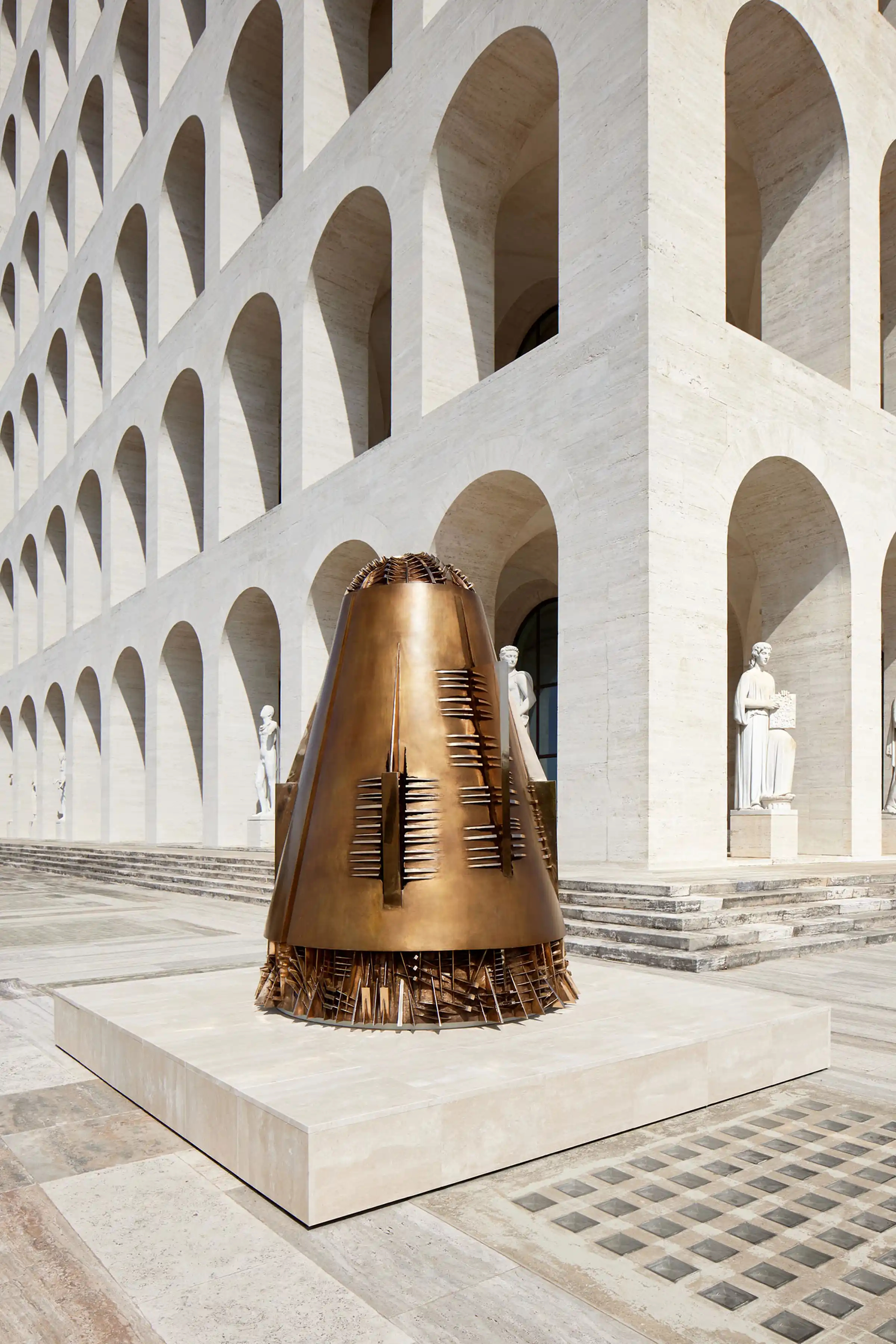
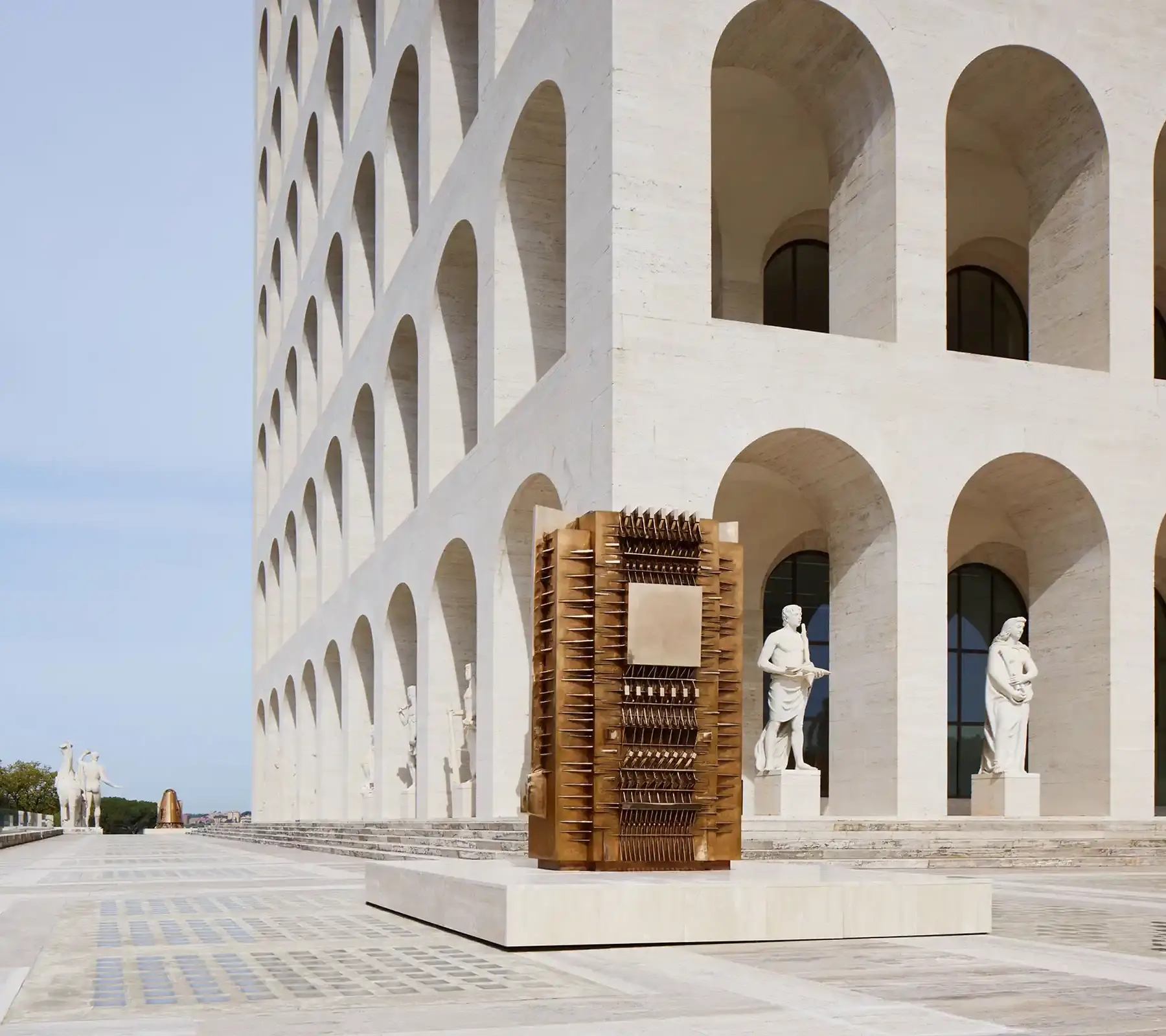

Standing today as stage backdrops between the Palazzo della Civiltà Italiana, the natural landscape and the surrounding urban community, the four sculptures once again act as “sounding boards of tradition, monuments in the very square where tragedy is acted out once more.” The primary structures of the geometric solids to which the sculptures refer (pyramid, cone, parallelepiped) are reshaped into a tangle of signs that reference human interference in nature, and the story recounted by Aeschylus. By redesigning the Palazzo della Civiltà Italiana’s very architecture as an alterable archetype, the four Forme del mito re-signify the building, transforming the so-called “Colosseo Quadrato” – a symbol of Italian Modernism and Rationalism, not to mention Fascist-era EUR architecture – into an open work, one that, like a re-staged play, may be reinterpreted, shorn of its cut-and-dried, defined interpretation.
The costumE-works
The theatrical action with which the exhibition kicks off outside the Palazzo della Civiltà Italiana is immediately followed by a specular presentation in the entrance vestibule, two costume-works the artist originally created for two stage plays: Costume di Didone (for Christopher Marlowe’s Dido, Queen of Carthage, staged and performed on the ruins of Gibellina on 6 September 1986), and Costume di Creonte (for Igor Stravinsky’s Oedipus Rex, staged and performed in Piazza Jacopo della Quercia in Siena on 19 August 1988). Made of sculptural and ephemeral materials such as raffia and fabric, the two costume-sculptures recall both the building’s current function as the international creative research and archival preservation headquarters of one of the world’s top contemporary fashion brands, and ancient iconographies and traditional techniques from African and Asian artworks that re-evoke the tale of the legendary stories of Dido and Creon.
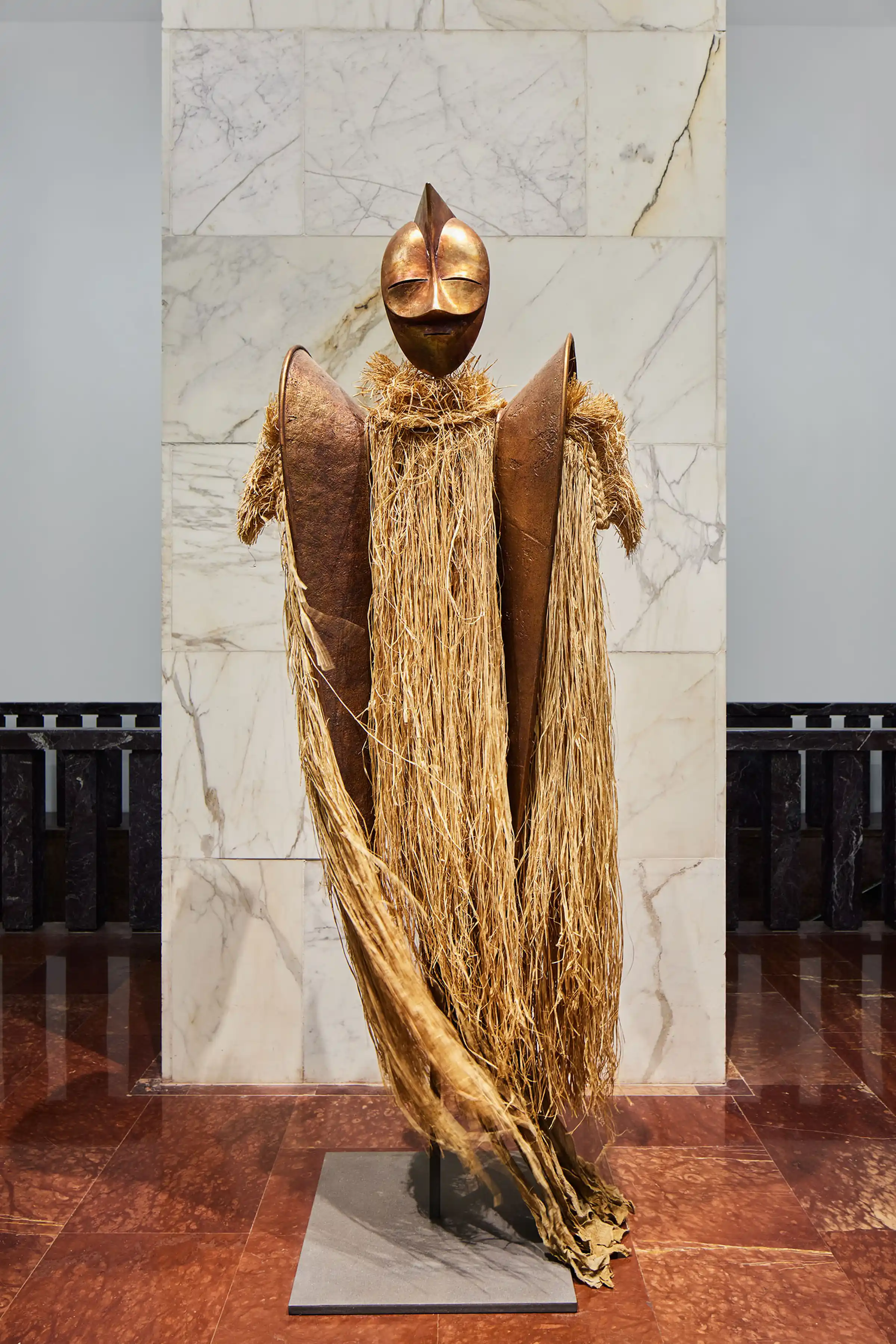
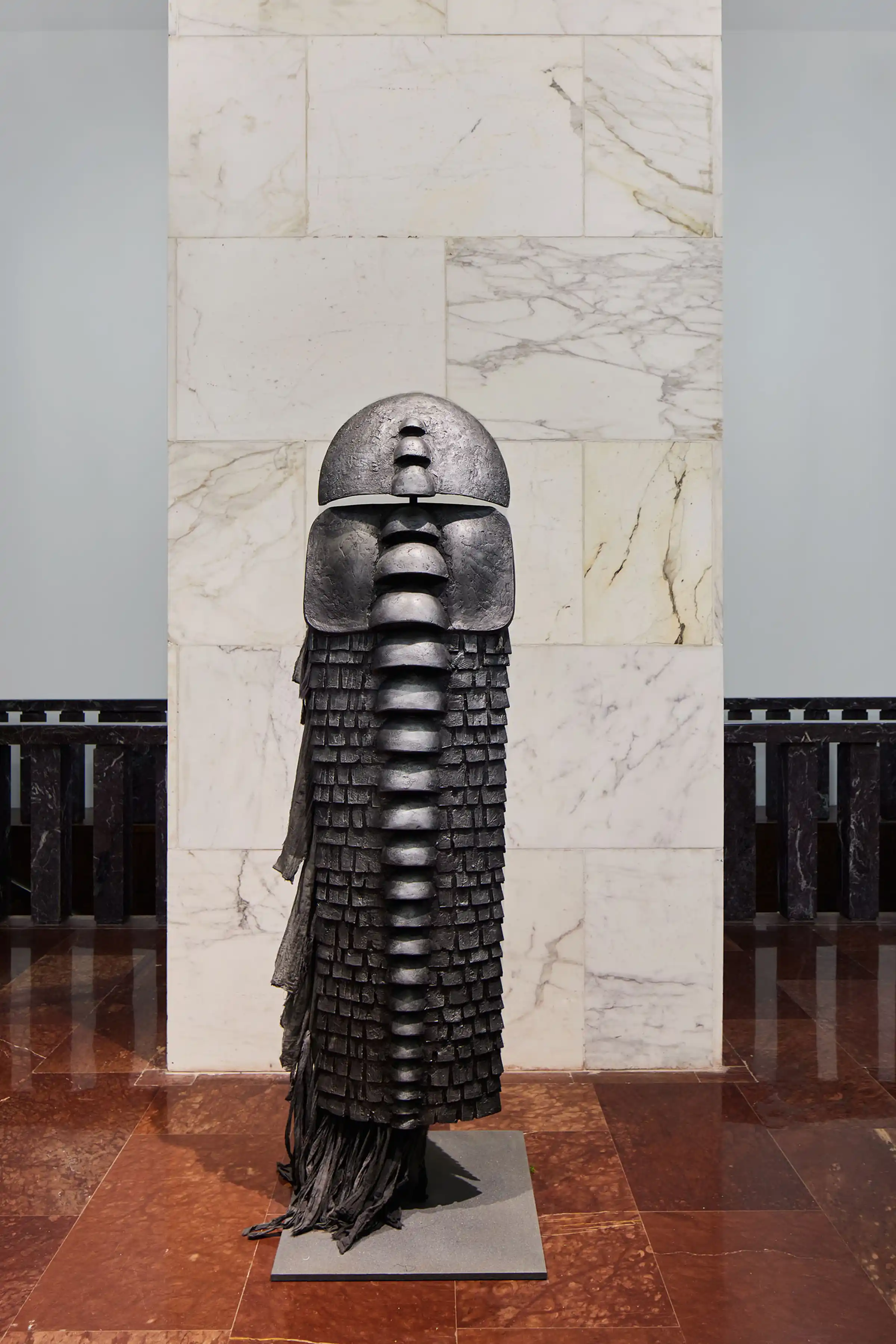
LE BATTAGLIE E MOVIMeNTO IN PIENA ARIA E NEL PROFONDO
Conceived as two acts of a play with a central interlude, the exhibition route binarily partitions into two mirrored galleries, plus a connecting back room. The two main galleries are symmetrically set up with two large-scale albeit contrasting-coloured environmental works, one black (Le Battaglie, 1995), the other white (Movimento in piena aria e nel profondo, 1996-1997).
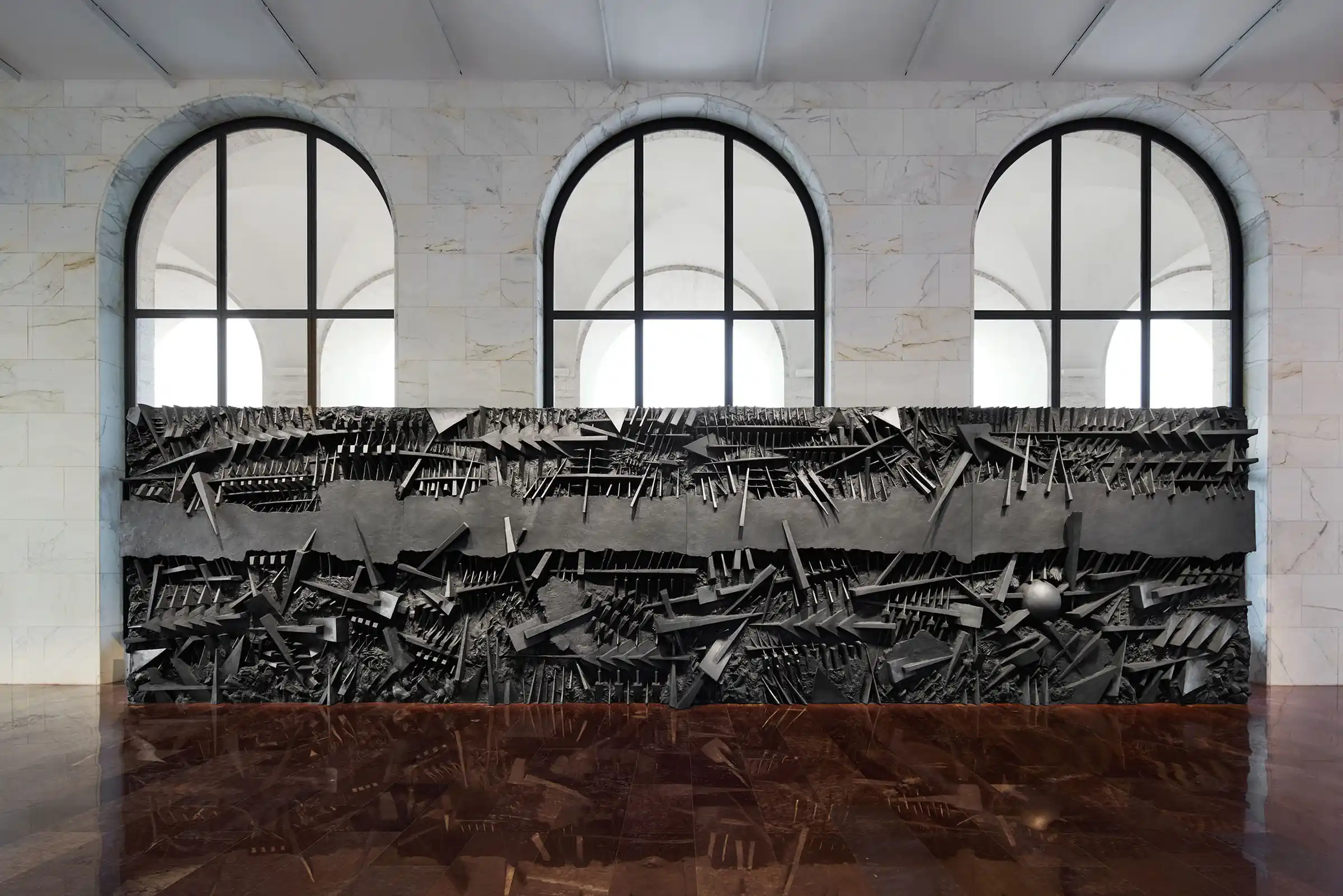
Characterized by sharp, edgy and angular shapes (teeth, arrows, spears...) and a variety of materials (tangles of ropes, wedges, bolts...), Le battaglie evokes a strong sense of dynamism and confusion, created by the clash and meeting of all its moving elements. As its matrix, Le battaglie evokes one of the masterpieces of the Italian Renaissance and perspective studies, Paolo Uccello’s triptych, The Battle of San Romano. Pomodoro, however, innervates its memory with the tension of his own expressive and material abstraction, formed in the 1950s in an encounter between memories of early 20th-century Expressionism, the practice of the Art Informel from around that time, and his own insight into a possible architectural and sculptural synthesis that would only fully emerge in the 1960s with the advent of Minimalism. The battle is not therefore just formal but spatial and temporal, crossing places and epochs, conveying them to the present day and actively involving us in them.
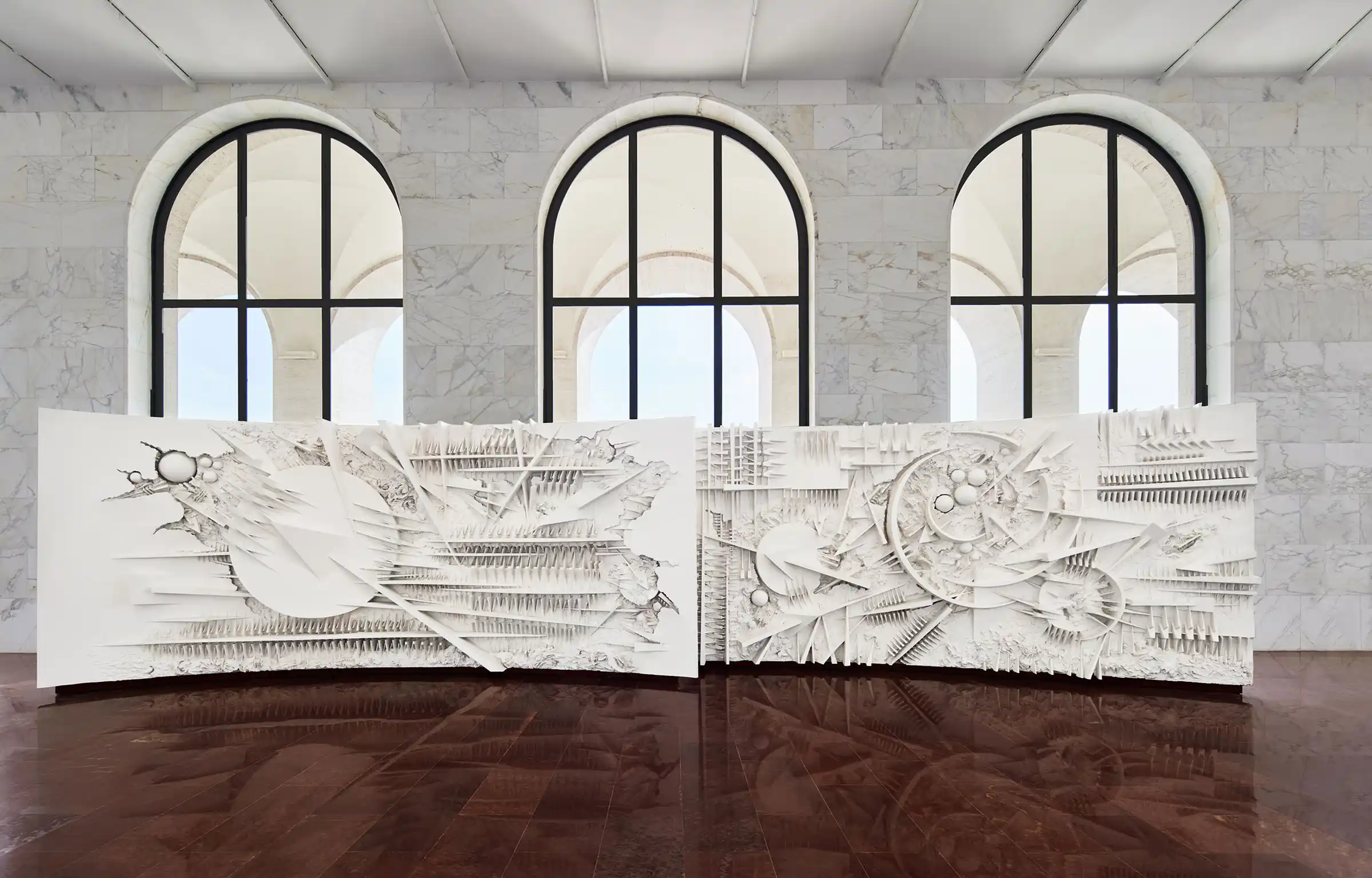
Movimento in piena aria e nel profondo consists of a double curve that dynamically encompasses both an evocation of great celestial (“according to the non-Euclidean geometry of modernity, the horizon is curved” says Pomodoro) and terrestrial spaces. The artist stages a sculptural action, deployed as an “excavation into the complexity of things.” As in the representation of a fossil, it is solidified by compressing Renaissance geometric perspective and modern and modernist perspectives that have become a widespread and dusty experience (Impressionism and Post-Impressionism), a multiple and interconnected point of view (Cubism), and dreamlike momentum (Surrealism), taking on the critical and self-critical awareness of being able to quantum-bend time and space, a possibility that this scenic backdrop (“in the open air and in the deep”) appears specifically to represent.
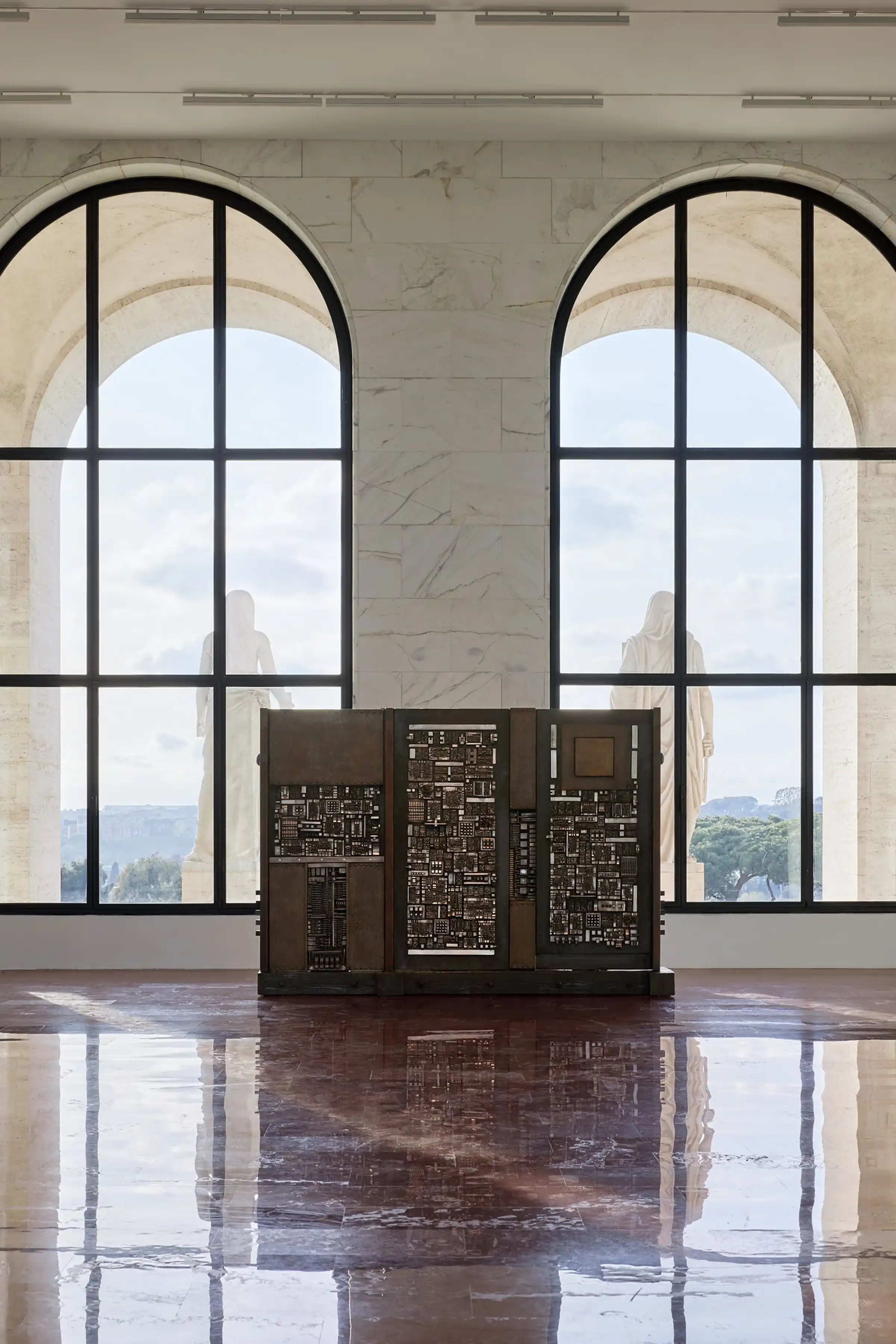
GRANDE TAVOLA DELlA MeMORIA
and IL CUBO
A dark dominant reverberates around the gallery in which Le Battaglie is placed, along with two other works that are among the most important in the artist’s research path, both of which deepen the narrative of his formative years and early development. After his early Tavole and Porte, the Grande tavola delLa mEmoria (1959-1965) cwas the outcome of the artist’s extended reflection on the technique of bas-relief, in which an Informel sensibility was structurally and conceptually filtered through the memory of the “very ancient technique” of cuttlebone working. The resulting dense palimpsest of signs invites us to slow down time and amplify memory.
“The surface of the sculpture requires a slow, close-up view of individual details, even if you’ve only just seen the monumental form as a whole and perceived the story’s overall rhythm.”
Arnaldo PomodoroSimilarly, Il Cubo (1961-1962) coincides with the start of the artist’s research into the elemental forms of Euclidean geometry and the geometric theme of solids, undermined, however, by his continuous splitting them up, running them through with signs, an approach that would recur in his later research, helping to define his own personal expressionist minimalism – or material abstraction – and corresponding to an immersion in the very codification of linguistic and historical expression.
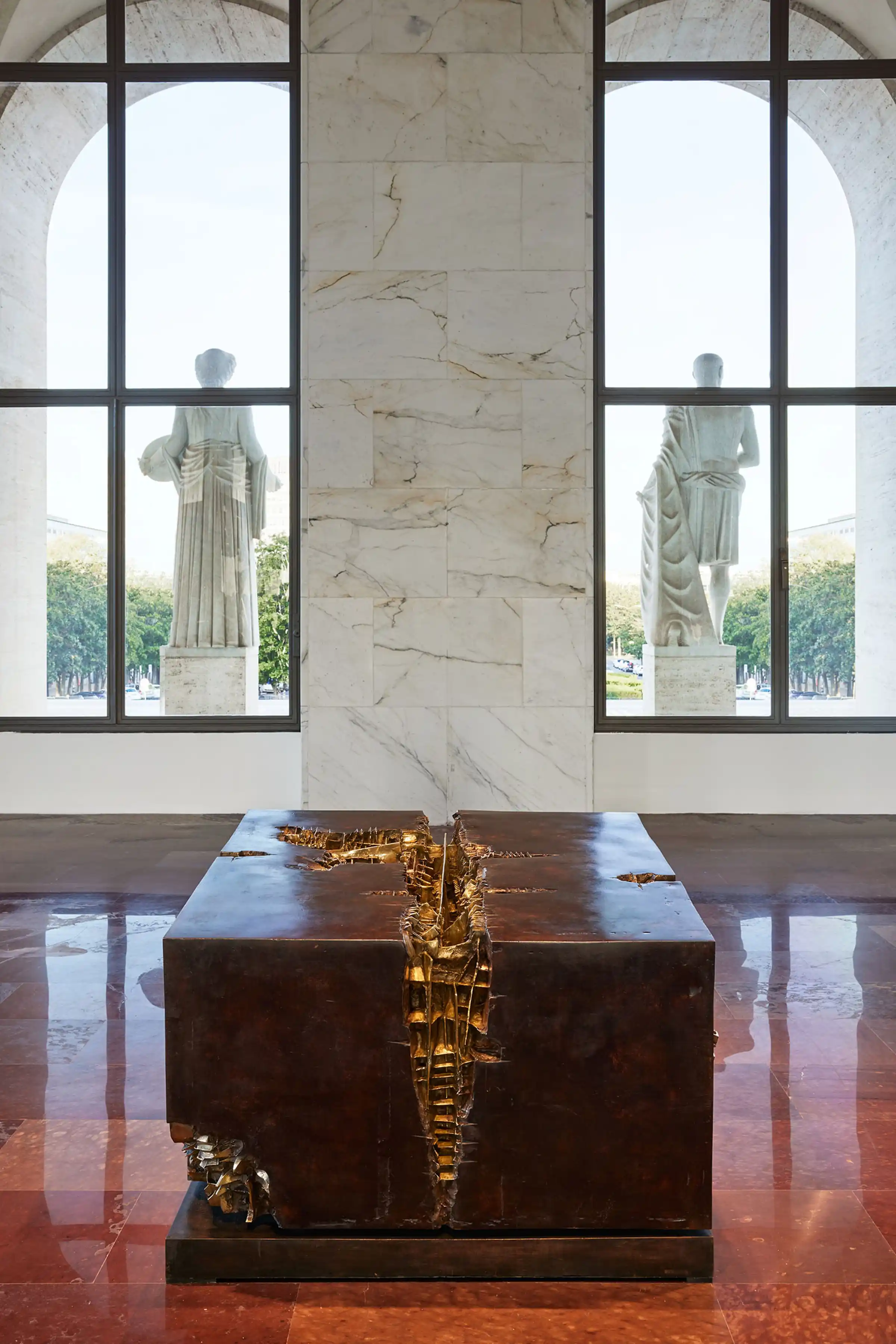
ROTATIVA DI BABILONIA
E TRACCE
Embracing the constitutive cyclicality of Continuum (the work presented in the exhibition’s finale that evokes the possibility of an eternal return, one in which end and beginning join together), Rotativa di Babilonia (1991) couples the two main galleries together, rendering them almost interchangeable. Mounted outdoors and visible through the Palazzo della Civiltà Italiana’s windows, the work evokes the possibility of a pathway that shuttles back and forth through time and space. Incorporating the spatially and temporally circular and continuous movement of the tracks a wheel leaves behind on the ground, Rotativa di Babilonia also constitutes an interlude, marking the transition from one act of a play to the next, indicating the continuity between a hypothetically preceding act (one gallery) and a hypothetically successive act (the other gallery). As Pomodoro states: “I see movement with its original instrument: the wheel, the origin of energy and the measure of time. The initial inspiration for this came in 1961, when on a trip to Mexico I saw an old Aztec calendar and made my first wheel.
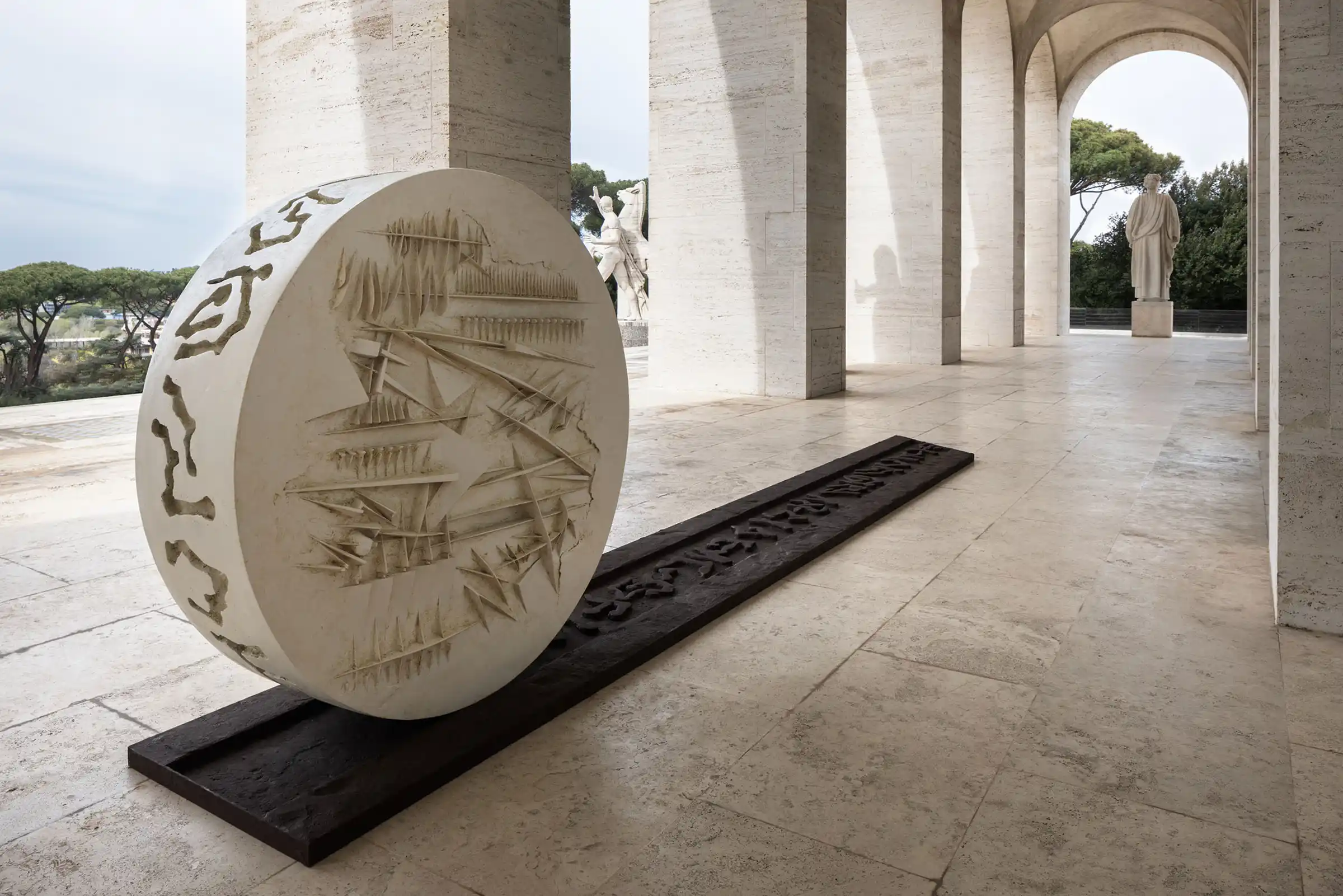

The Tracce I-VII (1998), twenty-one copperplate engravings in three colour variants (black, white and rust), is arranged along the inner corridor. Pomodoro declared: “I made a negative sheet of high-strength plastic material, like a violent and pressing mark which, lowering itself onto the sheet with the force of the press, ripples it with imprints that, almost like real reliefs, preserve the strength and severity of the bronze.”
CONTINUUM
The gallery where Movimento in piena aria e nel profondo, is the centrepiece with a clear reverberating dominant also features a work that ideally turns the exhibition back in on itself, like a circle allowing it to reverse its ending and restart from the beginning.

On the truly anthological value of Continuum (2010), Pomodoro says, “the simplified graphics of beginnings appeared: I wanted to fully return to occupying a grandiose surface with my earliest marks. Resuming and deepening the origins of my work, my early experiences of engraving on small plates, I’ve created a kind of infinite outline with the codes and inventory of all my ‘writing.’ And the writing is, in itself, continuous: one line after another, whether it be alphabetic or ideographic script.” By anthologizing and interrelating “all human marks, especially archaic ones: from early graffiti to Mesopotamian tablets, created to hand down memories and tales,” in this summa work Pomodoro traces out “an illegible lost language” in which, in “continuity,” he identifies both with his early works and those still to come.
OSSO DI SEPPIA
Soutside the exhibition – thus designed to be viewed by visitors to the building’s working areas – Osso di seppia (2011-2021), an element that makes up Ingresso nel labirinto from the Fondazione Arnaldo Pomodoro in Milan, is located on one of the Palazzo della Civiltà Italiana’s terraces. Cuttlebone is the humble yet universal matrix of all the artist’s sculptural works, an inspiration and reference that exists in nature, and one that is constantly referenced by the artifice of the artefact and artistic theorizing.

Pomodoro writes: “I began my work as a sculptor by scratching into cuttlebone, carving a series of small marks into it. Then I came up with the idea of using the outline of the bones themselves, enlarging them to become shields, sceptres and emblematic figures. Sometimes, I focused on studying all the lamellar structures within the bone; you wind up realizing some of them have an extraordinary internal texture, inspiringly so. Digging into cuttlebone to find these veins can evoke magical forms, even if you’ve done practically nothing. It is the cuttlebone, both a fragment of the beach and a portion of the Mediterranean, offering up evocations and images”. Emblematically, the work is displayed outside, removed from direct view like some vision either imagined or carried away by the wind, even if it is fixed in the mind of people who, like Pomodoro, have always interpreted sculpture as an act of understanding the world, the signs, forms and materials of its (infinitely possible) civilizations.
The exhibition within an exhibition
A double “exhibition within an exhibition,” the two main galleries feature design and documentary materials. For the most part never seen before, they are arranged in two modular structures that evoke the dual dimensions of studio and archive: a rack and four drawer units, which the public may open and consult. The learning pathway for these materials is split into three sections:Signs and Words. Les livres de peintre: a selection of the artist’s most important books, displayed in showcases above the chests of drawers;Research between Sign, Form, Space-Time: a selection of archival documents in drawers (sketches, drawings, models, letters, photographs, catalogues, etc.) organized into five thematic areas that cut across chronology and type of works/materials;Sites of the Project: a selected core of Pomodoro’s most significant designs, regardless of whether they were realized or not, each narrated through study and documentary materials visible on panels on the rack.
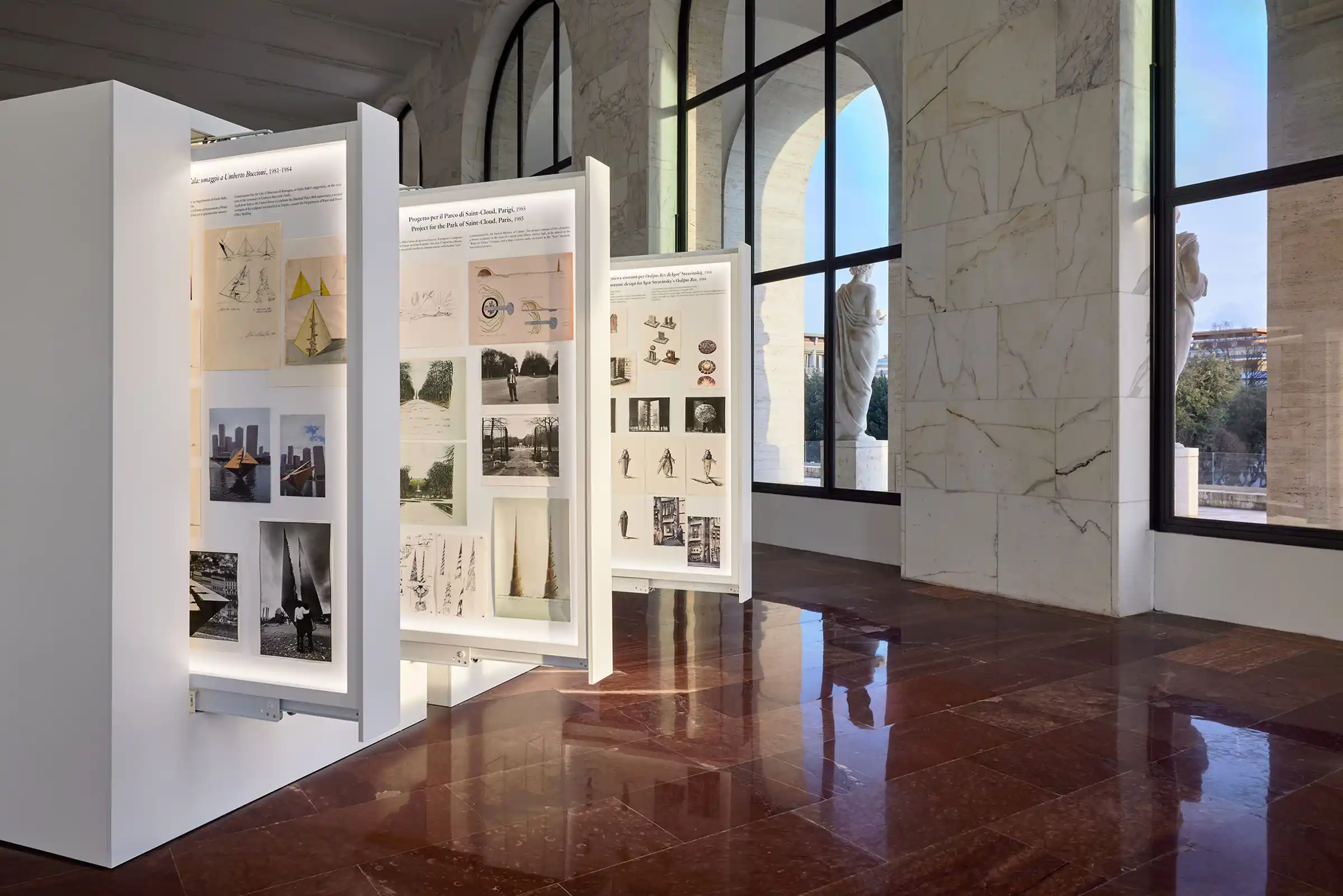
Photography: Agostino Osio






